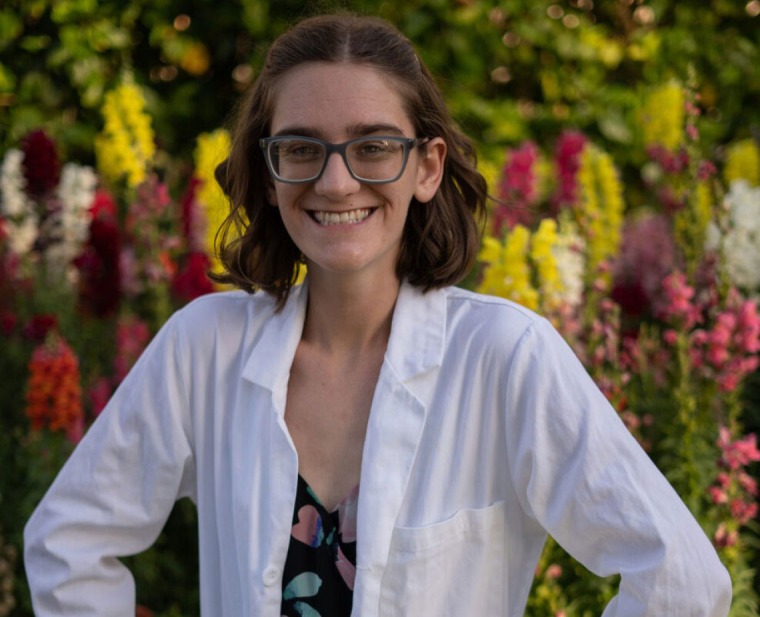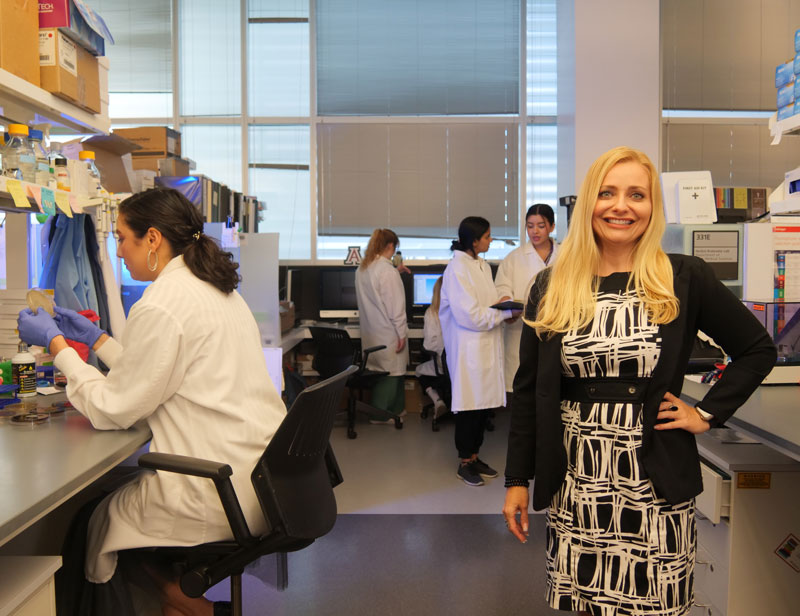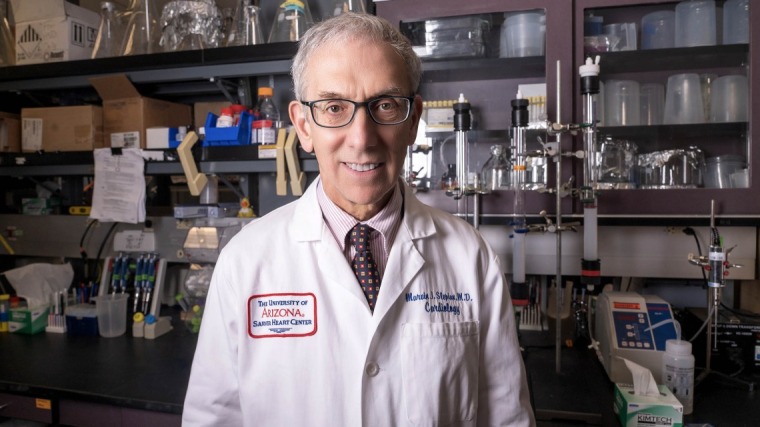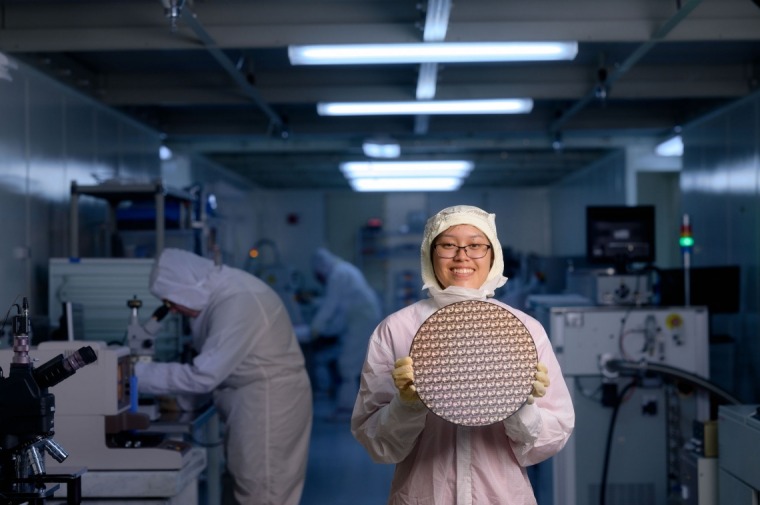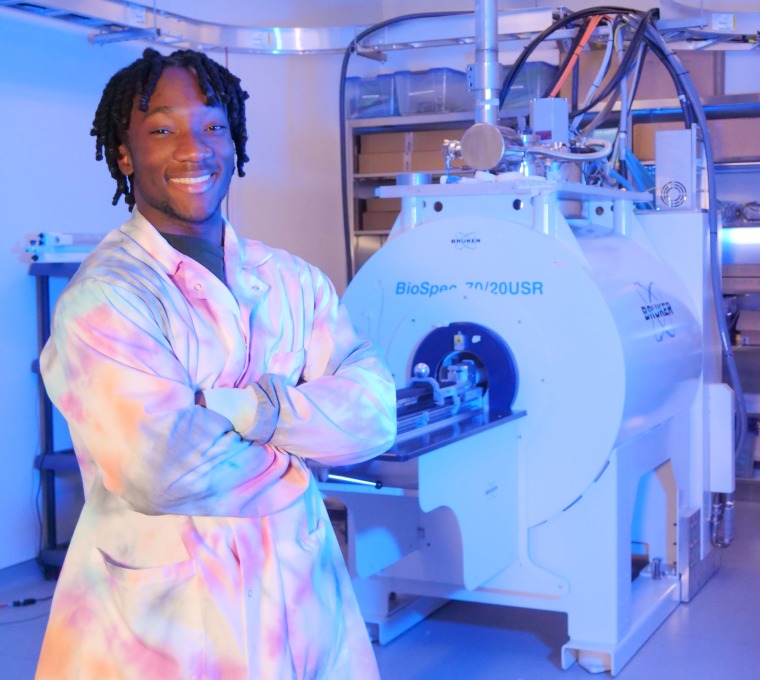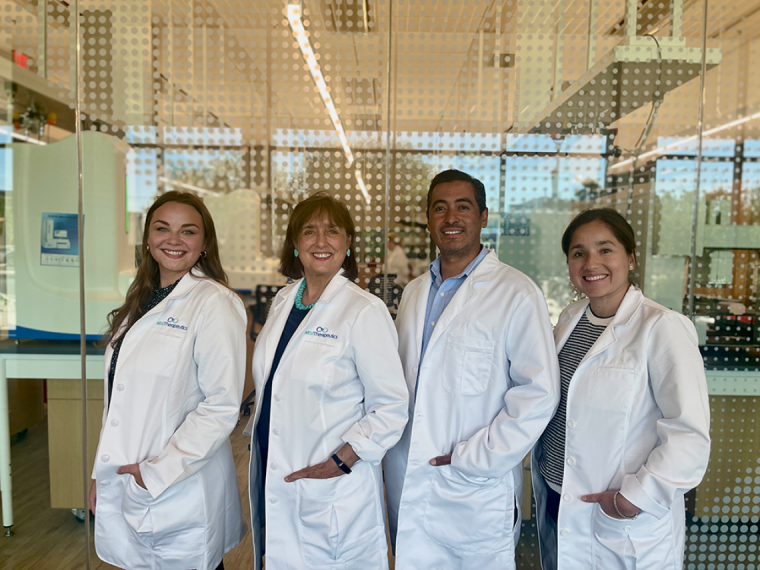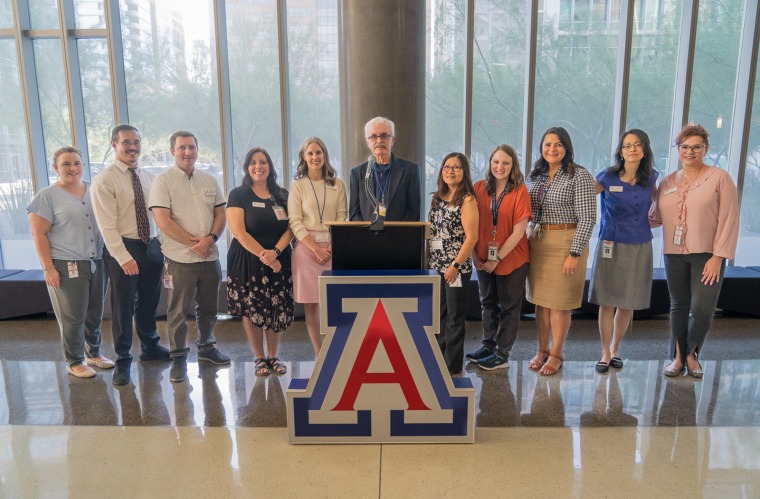Human cytomegalovirus (HCMV) is a herpesvirus that infects a majority of the world’s population. It’s a significant cause of viral induced birth defects and can cause complications in transplant patients or immunocompromised individuals. Amy Randall-Barber from the BIO5 Institute interviewed Dr. Rebekah Mokry, a postdoctoral research associate and 2023 BIO5 Postdoctoral Fellow in the Department of Immunobiology at the University of Arizona College of Medicine — Tucson. She received her PhD in microbiology and immunobiology at the Medical College of Wisconsin. Dr. Mokry currently works on HCMV replication and its modulation of cellular metabolism in the lab of Dr. John Purdy, associate professor of immunobiology and member of the BIO5 Institute. Better understanding those cellular metabolism interactions helps guide the development of novel antiviral therapies.
This interview has been edited for length and clarity.
ARB: Let’s start off with rapid-fire questions. First, fruit or vegetables?
I probably should say vegetable, but I'm going to go with fruit!
ARB: And would you rather travel to the past or future?
You know what, I want to be exactly where I am right now.
ARB: I like it! Thank you. What was it that brought you to the BIO5 Institute?
I was really excited about the research going on here. And in particular, I was excited about Dr. John Purdy’s research. He’s my mentor while I'm doing my postdoc here at the BIO5 Institute and is focused on lipidomics and metabolomics. That is research focused on identifying different nutrients within the body, and then identifying how many of them there might be. That was exactly the kind of training I wanted to acquire during my postdoc. It was a perfect match! The University of Arizona is absolutely wonderful and very collaborative.
ARB: That is awesome. You found him or did he find you?
It fell into my lap a little serendipitously. I happened to see Dr. Purdy give a talk at a scientific conference as I was ending my dissertation work. He was looking for postdocs, and as I was almost at the end of my graduate work, I thought I better reach out to find out more.
ARB: That's a great example of the accessibility of our researchers. It’s not a rare thing here at the BIO5 Institute!
That's something I noticed here at the University of Arizona. Everyone is very approachable. You can go and talk to somebody about their research and ask them if they can help you with your research. Everyone is so open, and I appreciate that. It’s something you really need as a scientist; you need to be able to collaborate and talk to make your science better.
ARB: You initially received an undergraduate degree in criminal justice. What made you decide you'd rather do science?
I love this question. I do get it a lot, because it's such an unusual pairing.
I have a dual degree from my undergrad, that is criminal justice and molecular biology. As it happened, I started my undergrad a little bit later than most people and thought I wanted to do criminal justice. I was set on that and so glad I did pursue it because it gave me a great understanding of the social sciences. It has helped me because life sciences, like molecular biology, touch social science. Especially when we think about improving diversity and culture and plugging that leaky pipeline that's in research.
My social science background has helped me understand some of these discrepancies and why they're happening.
ARB: That makes sense to me. They’re both part of the process.
What made Human cytomegalovirus (HCMV) become a focus of your research?
I hadn't intended to become a virologist. In fact, I didn’t want to be a microbiologist or study viruses since I didn’t know anything about them as an undergraduate. I thought it would be a bad idea for my graduate work. But I happened to rotate in a lab where they were studying human cytomegalovirus, or HCMV. I loved the research, and my mentor was amazing, Dr. Scott Terhune at the Medical College of Wisconsin. I thought, this is the best fit for me.
Initially, it was that the research is interesting, and I liked my mentor in this lab. And you know, that's what got me rolling. But as I began to get deeper into the literature and the research, I started to recognize what a terrible pathogen HCMV can be. What really drew me to continue to focus on HCMV was its connection to congenital birth disabilities. There are many foundations, like the National CMV Foundation and an organization here in Arizona, Stop CMV AZ. You go on these websites and see these wonderful children affected by CMV. While they’re still thriving, it has impacted both the children and their families. And that's what keeps me in this research project. I'm a basic science researcher, but I hope that my work will help clinical and translational research.
ARB: Of course. What is the greatest impact you hope to make with your research?
Along with hoping that my basic science can make an impact, I hope other people can build off my work for greater studies. I am also passionate about mentoring the next generation of students, and I love to go to high schools and be a science fair judge.
I am excited about ushering in this next generation of scientists and providing a better culture overall for them. It’s twofold with impact in that I hope my research has an impact, but I also hope I have an impact with training scientists.
ARB: Mentorship is so important. And here at the BIO5 Institute, I find we do much of it in different ways.
Absolutely. In ways you wouldn't even think would be normal mentoring. You can have so many different mentors that are important, from the research to the more personal side.
ARB: Speaking of mentors, do you have a mentor that impacted you?
I've had a lot of mentors and all of them have impacted me in some way. I'm appreciative of them all.
There was Dr. Tracy Lee at the University of Wisconsin-Parkside, she was my undergraduate mentor. During my graduate work, Dr. Scott Terhune at the Medical College of Wisconsin and members of my committee, Dr. Vera Tarakanova, Dr. Neil Hogg, and Dr. Michele Battle. Now here at the University of Arizona, it is Dr. Felicia Goodrum and Dr. John Purdy.
Of all the mentors that impacted my life the most, I have to say my parents. It may sound a bit cliche, but it's true. They are resilient and perseverant, and taught me everything I need to know while keeping my integrity. They are my biggest mentors.
ARB: I’m sure your parents are very proud of you!
You're a member of the BIO5 Postdoctoral Fellowship this year. Can you talk a little bit about how you heard about the fellowship and what project you are working on as part of the fellowship?
I heard about the fellowship through a previous awardee, Dr. Rob Jackson. He informed me of it and was kind enough to walk me through the process. I was so excited when I was awarded, and grateful to the BIO5 Institute for not just reading my application but believing in my research. A big thank you!
I feel like my research was impacted in a big way from the fellowship. Being awarded gave me the confidence to write other grants and expand on some of my ideas. That somebody believing in me pumped me up to start writing more.
Then there’s support for the research I’m working on. In Dr. John Purdy’s lab, we are interested in human cytomegalovirus and its interactions with host metabolism. When we're talking about the host, we're talking about humans, whose bodies have a certain metabolism associated with different tissues. We're seeking to understand how the virus hijacks some of these processes in order to replicate itself. My research focuses on how HCMV can acquire nutrients and then in terms of replication, what it is building with these nutrients.
Previous literature has shown how HCMV modulates different nutrients within the body. I’ll use a food analogy. If you're baking a cake, and you have all the ingredients in your kitchen to bake that cake, you will make a fantastic cake. In a similar manner, this is exactly how we model HCMV infection in cell culture. We give the virus all of the nutrients and the metabolites that it needs to replicate itself to an optimal level.
What I’m most interested in understanding is: what happens when we remove one of those ingredients? Or what if we limit one of those ingredients? If we're taking the cake analogy, let’s say we don’t have salt. The cake probably won’t taste as good. So, removing something or limiting a nutrient during HCMV replication, how will that impact virus replication?
The BIO5 Postdoctoral Fellowship is helping me through this by allowing me to purchase supplies, network at conferences, and communicate my research to other scientists and the public.
ARB: That’s great. I know that the BIO5 Postdoctoral Fellowship also provides a community. Do you find there are resources and a sense of community this year?
Yes. As I mentioned, the previous awardee told me about the fellowship, connecting with him was really important and now we’ve talked about grant opportunities. I’ve also communicated with my fellow postdocs in the fellowship and it’s great having a supportive community as we continue through our journey.
ARB: Shout-out to Michael Johnson for his brainchild there!
You mentioned that you are from Wisconsin, so how do you like Arizona?
I do like it! I love the University of Arizona and Arizona is stunning. It's beautiful, you can't get enough of those mountains surrounding you on all sides. But it is hot, I’ll say that. Truly, as a Midwest girl, I love the changing seasons. I love having all the seasons in one day, sometimes you get that in Wisconsin, but I certainly am enjoying my time while I'm here.
ARB: And the lack of snow shovels, right?
That’s a big thing! Not having to purchase a snowblower.
ARB: How long are you hoping to be here?
As a postdoc studying HCMV, it can last a few years. So, I'll probably be here at least another four. But that works perfectly for me because my daughter just entered high school this year. When she finishes high school, I will finish my postdoc, and then we will see where we both end up!
ARB: Very cool! If you could do it all over again, would you choose the same career path?
Oh, perfect question because I just picked up my Jurassic Park water bottle. I would be a paleontologist if I could do it all over again. Dinosaur bones are so cool.
ARB: They're very intriguing! Did you know there are dinosaur bones at the University of Arizona Gem and Mineral Museum? I highly recommend it.
So, when you were in elementary or middle school, what was your science fair project?
Great question. I was homeschooled for most of my education and didn’t have a typical science fair project. I would say daily, day-to-day activities were my science project, like watching the leaves turn in real time, or watching winter turn to spring as the flowers bloom. And that was my exposure to science, right? Watching the world with curiosity. Baking with my mom and cooking with my parents, that was the beginning of my science experience.
ARB: I think with anyone I talk to who is into science, it's that natural curiosity that starts it. Thank you so much for joining us, it was a pleasure talking to you. And thank you for being a part of the BIO5 Postdoctoral Fellowship!
Thank you so much for having me, I'm just so grateful.
